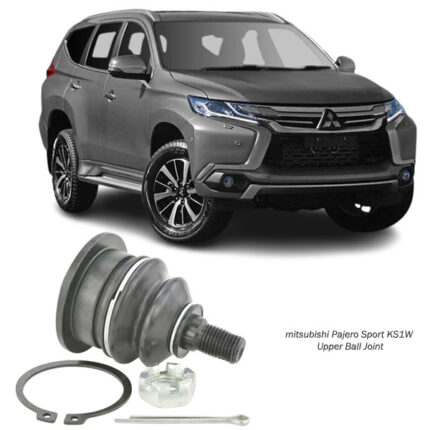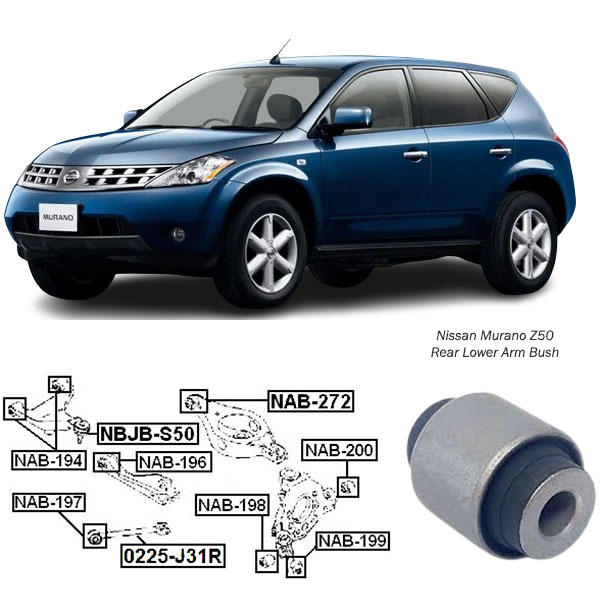-17%
Get Nissan Murano Z50 Rear Lower Arm Bush FB NAB-200 in Kenya
The rear lower arm bush is a rubber or polyurethane bushing located at the pivot points of the rear lower control arm. It serves as a cushioning element that absorbs shocks and vibrations from the road, providing a smoother ride and reducing the transmission of noise and harshness to the vehicle’s cabin.
Benefits;
1. Vibration Dampening
- Benefit: Rear lower arm bushings absorb and dampen vibrations transmitted from the road surface and the vehicle’s suspension system.
- Result: This helps to minimize road noise and vibrations, resulting in a smoother and more comfortable ride for occupants.
2. Improved Ride Quality
- Benefit: By reducing the transmission of vibrations and impacts, rear lower arm bushings enhance overall ride quality.
- Result: Occupants experience less jarring and discomfort when driving over rough or uneven road surfaces.
3. Enhanced Stability and Control
- Benefit: Rear lower arm bushings play a crucial role in maintaining proper alignment and stability of the rear suspension.
- Result: This ensures predictable handling characteristics, improved stability during cornering, and better overall control of the vehicle.
4. Reduced Noise, Vibration, and Harshness (NVH)
- Benefit: Rear lower arm bushings help minimize NVH levels within the vehicle cabin.
- Result: Drivers and passengers enjoy a quieter and more refined driving experience, with less intrusive noise, vibration, and harshness from the suspension system.
5. Longevity of Suspension Components
- Benefit: Rear lower arm bushings help to protect other suspension components from excessive wear and damage.
- Result: By providing cushioning and support, they extend the lifespan of components such as control arms, sway bars, and shock absorbers, reducing the need for premature replacement.
6. Maintained Wheel Alignment
- Benefit: Rear lower arm bushings help to maintain proper wheel alignment by keeping the rear suspension geometry in check.
- Result: This ensures even tire wear, optimal tire contact with the road surface, and improved handling and stability.
7. Improved Traction and Stability
- Benefit: Rear lower arm bushings contribute to maintaining consistent tire contact with the road surface.
- Result: This enhances traction and stability, especially during acceleration, braking, and cornering maneuvers.
8. Prevention of Chassis Sway
- Benefit: Rear lower arm bushings help minimize lateral movement of the vehicle’s chassis during cornering and maneuvering.
- Result: This reduces body roll, enhances cornering stability, and improves overall vehicle control and confidence.
9. Enhanced Safety
- Benefit: Properly functioning rear lower arm bushings are essential for maintaining the structural integrity and safety of the vehicle’s suspension system.
- Result: They help prevent premature wear, component failure, and potential safety hazards that could result from degraded or faulty bushings.
Signs a car needs a new one;
Clunking or Knocking Noises
- Explanation: Worn or damaged rear lower arm bushings can allow excessive movement of the control arm, leading to metal-to-metal contact and noise.
- Symptoms: Clunking, knocking, or rattling sounds coming from the rear suspension, especially when driving over bumps or rough roads.
2. Vibration or Shaking
- Explanation: As the rear lower arm bushings deteriorate, they may no longer effectively dampen vibrations from the road.
- Symptoms: Increased vibrations or shaking felt in the vehicle, particularly noticeable in the rear end or through the seat while driving, especially at higher speeds.
3. Unstable Handling
- Explanation: Worn rear lower arm bushings can affect the alignment and stability of the rear wheels.
- Symptoms: The vehicle may feel loose or unstable, with excessive sway or body roll when cornering or changing lanes. Handling may feel imprecise, and the car may be more difficult to control.
4. Uneven Tire Wear
- Explanation: Damaged rear lower arm bushings can lead to changes in wheel alignment, causing uneven tire wear.
- Symptoms: Check the rear tires for signs of uneven tread wear, such as excessive wear on the inner or outer edges. This uneven wear pattern can indicate alignment issues due to worn bushings.
5. Increased Steering Effort
- Explanation: Worn rear lower arm bushings can affect the vehicle’s steering responsiveness.
- Symptoms: The steering may feel heavier or require more effort to turn, especially when maneuvering at low speeds or parking.
6. Visible Damage or Wear
- Explanation: Visual inspection can reveal signs of bushing wear or damage.
- Symptoms: Inspect the rear lower arm bushings for cracks, tears, or deformation in the rubber material. Additionally, look for signs of separation between the bushing and its mounting surface.
7. Alignment Issues
- Explanation: Changes in wheel alignment can occur due to worn rear lower arm bushings.
- Symptoms: The vehicle may pull to one side while driving, and the steering wheel may not return to its centered position after making turns.
8. Increased Road Noise
- Explanation: Worn rear lower arm bushings may allow more road noise to enter the cabin.
- Symptoms: An increase in road noise or a rougher ride quality, especially over rough or uneven road surfaces.
9. Difficulty Maintaining Control
- Explanation: As rear lower arm bushings wear out, the vehicle’s stability and control may be compromised.
- Symptoms: The car may feel less planted on the road, with a tendency to wander or drift, especially at higher speeds or during sudden maneuvers.
Follow us on Facebook for more parts.



